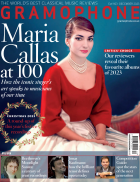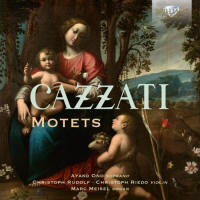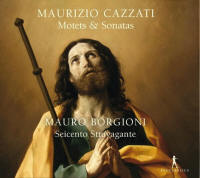Texte paru dans: / Appeared in:
|
|||||||
|
Outil de traduction |
|||||||
|
There has been a spate of Cazzati anthologies this year. Barring the odd appearance in collections (think of the Gabrieli Consort’s Vespers anthologies), the discography has little to show for an exceptionally enterprising career as a music printer and itinerant maestro di cappella (in his will he directed what was to be done with his printing press), culminating in a 14-year stint at the Basilica of San Petronio in Bologna. But these two recordings are especially well matched, for conceptually they are carbon copies, with just one duplicate between them. Both focus on genres in which Cazzati produced some of his most distinctive work: solo motets (sometimes with two obbligato violin parts) and instrumental music. The unnamed ensemble fronted by soprano Ayako Ono uses the charismatic, atmospheric organ of Fribourg Cathedral, built during Cazzati’s lifetime, on the continuo, while baritone Mauro Borgioni and Seicento Stravagante alternate harpsichord and organ, and substitute a cornett for one of the fiddles.
Ono and friends offer the more engaging programme, perhaps because some of the instrumental pieces are by other composers. (Ironically, one of these, the organist Giulio Cesare Arresti, was a persistent thorn in Cazzati’s flesh at San Petronio.) The well-tried chromatic subject of Giovanni Paolo Colonna’s keyboard sonata is put through its paces with zest, and the violinists acquit themselves with style, whether by themselves or when accompanying Ono. The Salve regina by Cazzati that opens the recital has the flair and sentiment worthy of the solo motet at its best, and the extrovert O caelites shows off the singer at hers. Elsewhere, it must be said that she is more hesitant, the music’s technical demands at times just out of reach (bafflingly, there is an audible breath between the two syllables of the opening word, ‘Salve’). This tentative quality is a shame, for Ono’s gentle tone is well matched to the music’s pathos (try the beginning of Qui bella geritis). She is not ideally served by a sound recording that makes her and the organ seem slightly recessed in relation to the two violins. (The position of the microphones for the solo organ pieces appears to be closer, and none the worse for it; at other times, such as the recital’s very last chord, one can hardly make out the organ’s bass note.) For all that, there are moments of great beauty, and the selection of music earns this a qualified recommendation.
Seicento Stravagante’s contrasting timbres of violin and cornett complement each other well, and the cornettist has the chops and considerable delicacy (try La Calva), though the tone is not always as centred and rounded as one might like, especially up top. There are none of the problems in the sound recording mentioned in the rival set, but the chamber organ isn’t as distinctive as its church-dwelling cousin. Mauro Borgioni is a more assured presence than Ono but he too is prone to momentary lapses of intonation (especially in coloratura passages, on which Cazzati doesn’t stint), and is less precise in his coloratura than she. He’s not afraid to attack the top of his range, nor on occasion exceed it (try the Regina coeli), but his timbral and expressive palette might be broader still, to get the most out of the music’s dramatic potential. (And I wish he wouldn’t roll his Rs quite so much.)
But there’s no doubt of Borgioni’s expressive sense: the beginning of Dulcis amor proves it, and incidentally shows off Cazzati’s melodic gift, even in the formulaic arioso mould. On the whole, the cornettist David Brutti deserves a billing on a par with Borgioni; lovers of the instrument are bound to enjoy this. The texts aren’t translated, which, given that many are bespoke (or uncommon, anyway), is a serious omission. |
|||||||





